Setting bits necessary to complete the prosthetic tooth. Modern crowns are able to eliminate almost all possible defects, as they are fixed structures of the natural form that is identical to a healthy tooth or even the best in terms of chewing properties. With the help of the latest advances dentistry crowns can eliminate even serious deficiencies of the dentition.
Indications for the installation of crowns
Patients regularly visiting your dentist, you can learn to install crown directly from him long before an urgent need. In other cases (long-term neglect of dental disease or injury) a dentist needs some time for examination (visual inspection, x-rays and other tests) to make the conclusion about the necessity of dental prosthetics.
The main reasons for the installation of crowns include:
- The distribution of carious lesions by more than 50% of dental tissues in the presence of a healthy, strong root to establish a pin;
- The sharp deterioration of aesthetic appearance (e.g. color change) of one or more teeth;
- Rapidly progressive destruction of the tooth for non-carious disease;
- Full tooth loss due to gum disease and periodontal;
- Pathological abrasion of enamel one or more teeth;
- Destruction of teeth adjacent to the damaged for installation of metal-ceramic bridge.
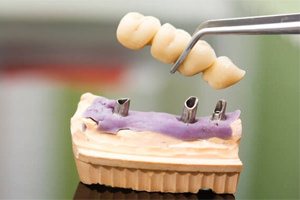
Preparation for prosthetics
For most people any dental procedures are associated with a characteristic unbearable dental pain and inconvenience of a dentist’s office. But do not be afraid of the installation of prostheses, the most unpleasant stage of this operation – turning the tooth – it is much easier tolerated than standard scrubbing of tooth decay with a drill. Moreover, all operations occur under local anesthesia the most effective drugs.
Other stages of preparation for dental prosthetics include cleaning plaque and Tartar removal, and treatment of dental caries. If the tooth on which you are installing the crown is too damaged, before prosthetics are restoring it.
For starters, the teeth, the treatment of which is meaningless will be deleted. Two weeks later, the prosthesis continues in full antiseptic treatment of the oral cavity, filling of canals and carious cavities of permanent control with the help of x-rays. In the case of the establishment of the pin will be removed also the root of the tooth, unable to hold the prosthesis.
Sometimes a crown is set on living teeth, i.e., tooth decay is cut the damaged part of the tooth and it is placed the prosthesis. Lightweight version of the procedure can be for young people on the teeth, the affected single source of caries.
All decisions about ways to protect and prosthetics, the patient decides after the consultation, the dentist.
The types of dental crowns
Now there are many types of crowns, so for their correct discernment, there is a special classification on several grounds.
By appointment are:
- Restorative crowns are needed for possible anatomical, functional and aesthetic restoration of the lost tooth.
- Reference crowns, which are the basis for the bridge.
Material of the bit can be:
- Metal;
- Metal-composite;
- Metal-ceramic;
- Ceramic;
- Porcelain;
- Zirconium.
By construction, the crowns are distinguished:
- Full – fully replaces the lost tooth.
- Akvatoria – is a metal band that is tightened around the tooth to maintain its natural tissue with partial damage.
- Cultivee – crowns, in-depth in the gums.
- Polygoni – Replace all the parts of the tooth, in addition to the inside (facing the tongue) side. Subsequently can perform the function of the support bridge or cantilever of the prosthesis.
- Telescopic – special crowns, the height of which is relatively gums can be adjusted after installation of the prosthesis.
- Pin – used to install a titanium pin replacement is too weak or the affected root in case of strong tooth decay.
- Raketnye, window and others.
Metal crowns
What are crowns on teeth chewing it is best to put? Many experts suggest metal, because they have a lot of advantages, but their cost is relatively low. This can be made of different metals.
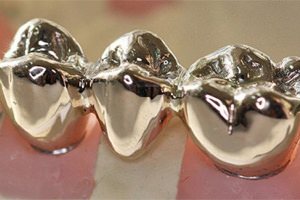
Metal crowns are a classic example of prosthetics and are used for several decades. The most common option is the teeth gold.
The main advantages of these crowns is durability, reliability and strength. The elements are practically not subjected to oxidation, and their index of abrasion of the maximum is correlated with the natural enamel, so teeth-antagonists during mastication are not damaged. The drawback with this design, only one unsightly, so it is usually set to unavailable to the public eye region.
All-metal crowns are cast and stamped. Stamped apply to older type designs, are manufactured based on casings made of steel, which makes the coating in the color of gold. Look unattractive, are unstable in comparison with cast structures. The advantage of these crowns is a reasonable price and minimal damage to the tooth during the machining required to install them.
Monolithic crowns are made based on the tooth cast metal, with their low cost they don’t wear out the teeth and are long, though, and are not aesthetic.
To the tangible disadvantages of these crowns is their unattractiveness – tooth with a metal crown is significantly different in appearance from natural teeth, as well as the low wear resistance due to the thin walls. But perhaps most importantly their negative property – not a snug fit to the surface of the tooth, which the crown can breed harmful bacteria, causing tooth decay.
Metal-composite crown
Composite crowns are made of metal base and plastic frame. This is one of the quite available materials, the advantage of which in comparison with the pure metal is the external natural appearance of the tooth.

At metal-composite crowns metal part must be cast, so she clings to the root and does not pass to him bacteria.
Unfortunately, the plastic lining wears out relatively quickly that appears to change its color to grey, the swelling due to the frequent contact with fluids and weakening its strength until the deposition of the metallic base.
Also install metal-composite crowns only to people who are not prone to allergic reactions as the plastic can highlight in the saliva of specific harmful substances.
In connection with the merits and demerits of material metal-composite crowns are used only as a temporary prosthesis. Most often it is necessary to restore the tooth at the time of manufacture or implantation of pins and other orthopedic structures.
Metal-ceramic crowns
Metal crown consists of a metal base with a thickness of 0.2-0.5 mm and the ceramic veneer. Metal for the frame chosen by the patient based on the cost of the material and its properties – wear resistance, hardness, inertness in relation to the body and other qualities. Dentistry find the various inert alloys and pure metals: Nickel, gold, palladium, platinum, etc.
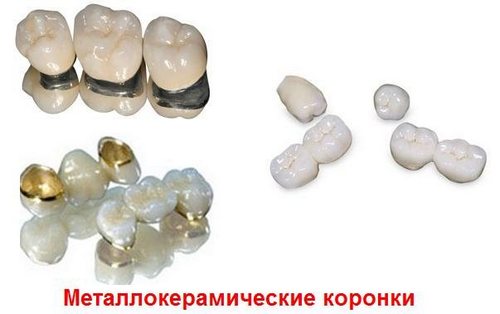
A metal frame allows you to more firmly hold the crown that is virtually indistinguishable from nastojashego, and reduces the cost of the prosthesis compared to a fully ceramic or porcelain base.
The advantages of this type of crowns is their strength, availability, reliability, and good aesthetic conformity to natural tooth. Unfortunately, the installation of metal-ceramic prosthesis is necessary deponirovanie (removal of the nerve) of the tooth and a long bridging up to 2 mm natural hard tissues.
Ceramic crowns
As you can tell from the title, the ceramic crown is made entirely of ceramics without a frame. The lack of metal parts makes the prosthesis is indistinguishable from a natural tooth, so it does not stand out from the dentition, i.e., has excellent aesthetic properties. In the strength and reliability of ceramic crown not inferior to metal-ceramic, but is much more expensive.
To create this type of dentures using porcelain, Zirconia or, in rare cases, aluminum oxide.
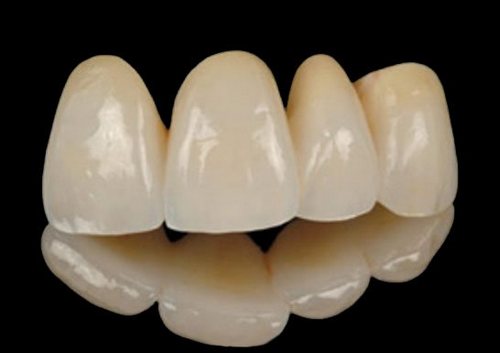
Porcelain crowns
Porcelain from the available for a person of artificial materials has the closest to natural teeth physico-optical properties. Properly manufactured prosthesis made of porcelain has a shade and translucency according to the remaining teeth, and there is no doubt in artificiality from the abstract observer. This achieves perfect aesthetics, which is unable to give any other known and convenient to handle material.
Of course, a porcelain crown in its own way is the perfect prosthesis, but in some cases it is not relevant, for example, in the manufacture of metal-ceramic bridge.
Design of Zirconia
The most perfect prosthesis is considered the ceramic crown on a zirconium basis. This type of crown takes the best from metal-ceramic (durability, reliability) and ceramic (aesthetic ideal), although technically it is a subspecies of ceramic dentures.
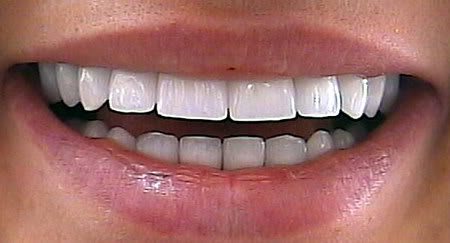
Zirconia, unlike metals, is the best material for the frame, as it has svetopropuskanie properties and gives you the opportunity to provide a more accurate fit.
This makes it possible to produce excellent single and bridge ceramic dentures, the only significant drawback is their high cost.
The ways of fixing crowns
Now that we got all varieties of crowns and features of the materials from which they are made, you need to understand, due to which the prosthesis will be fixed in the jaw, whether it affects the adjacent teeth and how durable is the resulting synthetic analogue.

Modern dentistry allow you to install a crown in one of three ways.
Fixation on the pin
Pin – the most common method of fastening the crown, as it is not very costly, on the strength corresponds to a real tooth and is quite easy to install. By itself, the pin is metal, plastic or rubber rod that is placed in the root of the alveolar socket and secured it with a special hardening solutions.
Intracanal pin requires a healthy tooth root, sufficient in size for the installation of artificial support. For tooth with single channel the possibility of placing the pin is limited in the case of small dimensions of the root, and for a tooth with multiple channels even when their health is too twisted and subtle moves become an obstacle to the installation of the pin.
In any case, the pin is also prohibited to put in such cases:
- In case of serious diseases of the blood or nerves;
- For injuries and diseases of the periodontium;
- Fixed obstruction of the channels of the tooth that interferes with their quality sealing;
- When detected at the root tip, which is planned to place a pin, cystic masses.
From the material of the pin, will largely depend on the technical characteristics of the prosthesis: strength, elasticity, safe for fabrics, etc. If it is anticipated prolonged high load on the tooth, use an elastic carbon fiber pin, if there is a negative reaction of tissue to any materials, recommend titanium or zirconium rod. The installation of the pin is the second bad operation for prosthesis, after which the attachment and fixing of the crowns occurs without pain and discomfort.
Fixing the crown tab
Post-and-core tab is a cast of the stump of the tooth root portion. To set this construction the root of the tooth is sealed the same way as for the pin, and a hole is prepared in which is laid the root of the tab. If possible, the root portion can be branched according to the number of channels of the tooth and team to facilitate insertion of the tabs in non-parallel channels. The crown is cemented on the stump as well as honed natural tooth.
For metal and metal-ceramic crowns use tabs from cobalt-chromium alloy, and the ceramic will need a tab made of zirconium, as the dark metal peeks through and gives the ceramics crown bluish tint.
The prosthesis on the stump tab is considered to be more durable than the pin design.
Crowns based on dental implants
Permanent dentures are much more reliable than a removable design, they also do not stand out among the dentition and can last for much longer. However, in order to set the crown requires strong fixation on the patient’s teeth, often with a long exposure required for the formation of future support of the prosthesis.
Unfortunately, not always maintained a strong tooth root, which could hold the crown. In this case, it requires a complete prosthetic tooth that begins with the implant – titanium, plastic or fiberglass screw, similar to a small bolt which can be screwed in place of the lost root.
Implantation of a dental prosthesis is longer and more difficult installation of a crown on the remaining tooth or the root, but the result is the patient receives, in fact, the new tooth is not susceptible to caries and other diseases and is not able to support in principle. For front teeth it is possible to install ceramic abutment, by which the implant becomes completely undetectable, and hence, the artificial tooth looks to be identical to the present.
Turning the tooth prior to installing the crown
To preserve the natural shape of the tooth after installation of crowns and to ensure a snug fit, should be turning the tooth. It is a painful and unpleasant procedure, during which grinds 1-2 mm of hard tissues from the tooth surface. The amount of turning depends on the thickness of the crown and varies depending on the material used in its manufacture – so, ceramic crowns require a minimum of turning, in contrast to metal structures.
The procedure is performed under local anesthesia, so the patient feels no pain. In some cases, it is recommended to remove the pulp so you don’t burn it while turning. In the processing of chewing teeth the risk of burns not so great, so they are trying to keep alive.
The procedure for removal of a nerve or tooth pulp is processing of the channels and their filling, and otherwise inflammatory processes. If deponirovanie and filling of root canals was done improperly, it may be necessary to cut the set design for treatment that threatens extra costs and can be traumatic for the tooth.
The laboratory stage of preparation for prosthetics
In the dental laboratory based on impressions of the tooth provided by the dentist, cast a plaster model which is then used for casting crowns made of metal.
During the manufacture of the permanent crown made of metal or ceramic, the patient can establish a temporary structure of plastic, which will protect sharpened tooth from damage and restore its chewing function. They are fixed in temporary cement and are easily removed when you need to install a permanent crown, allow to maintain the aesthetic appearance of the teeth.
Fitting and installation – in the final stages of prosthetics
Installing crown takes place in three stages. The first of them is the fitting, it is necessary to determine the quality of fabricated construction and how tightly it adheres to the tooth. Only then produce ceramic layering on the metal frame and its fixation on the cult of temporary cement.
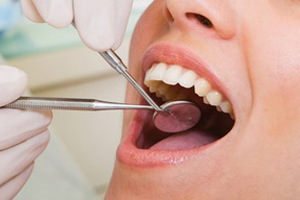
Temporary crown cement is kept for a few weeks, during which I observe, does it the process of mastication, does not create any problems with the bite. An important indicator of the quality of installation of crowns is its closure with the teeth-antagonists, otherwise the natural teeth are greatly damaged.
Only after a couple of weeks if there are no problems with occlusion and complaints of the patient, the crown is fixed permanently using dental cement.
In some cases, the crown need to be removed?
The process of removing the crown complex and time-consuming, is performed only by a specialist with an Arsenal of necessary tools – dental discs, which cut the design.
A crown it is necessary to remove in the following cases:
- Upon expiration of the operation;
- If there is any damage, warping, chips or cracks dental crowns.
- If the tooth under the crown is starting to hurt due to the inflammatory process, the crown must be removed in order to undertake his treatment; the reason for the tooth pain could be a cyst, remnants of the dental instruments, an inflammation of the upper channel;
- When properly carried out the procedure of installation of crowns, whereby it loosely adheres to the tooth.
The most common situation in which it is necessary to remove bit – error doctor on the stage of preparation of the tooth and canal filling. Perforation of the channel walls, debris, tools, neoprobirovannye the top channels lead to inflammation and soreness of the tooth, causing to wear the crown becomes impossible until after treatment.
To warn it is necessary in the treatment process to continually monitor the quality of work the dentist with x-rays. Otherwise, increases the risk of complications, and to correct the mistakes of the dentist will have another clinic at his own expense.
Answers to frequently asked questions
- The doctor offers to put crowns on teeth. Is it safe to have tooth to do the turning? For quality installation of crowns required turning the teeth so that the crown fits snugly against its surface. Turning itself is very traumatic because it disrupts the protective layer of tooth enamel and makes the tooth more vulnerable to bacteria and mechanical damage, but we cannot live without it.
- How much is a crown on the tooth-metal? Prices for metal-ceramic crowns depends on the type of metal and its quantity used in the manufacture. The cost of crowns varies 3-40 thousand rubles.
- Looks like a crown on the tooth made of ceramics.Whether such a crown placed on the chewing teeth? Ceramic crowns are aesthetically pleasing and completely indistinguishable from natural teeth, but is inferior in strength and wear resistance of the cermet. Therefore, to install on the chewing teeth, which are subjected to heavy loads, it is preferable to use metal-ceramic crowns.
- Than dental crowns is glued to the tooth? To ensure a tight fit of the crown to the tooth, the dentist uses a special adhesive or dental cement.
- Spoiled if the teeth under the crown? Crowns preserve the tooth from damage, reducing mechanical stress, which falls on him in the process of chewing food, but also protect it from microbial action. Therefore, when properly installed, the crowns, the tooth decay will not.
- How to clean dental crowns? Hygiene of natural teeth and teeth with a crown installed is no different – they are also cleaned with a toothbrush and toothpaste, and interdental spaces floss handle.
- If after you install crowns on teeth to be any complications? If before, how to install a crown, the dentist conducted a qualitative treatment of the tooth, then further problems arise.
Prices for dental crowns
Prices for crowns are dependent on many factors, including the availability of own laboratory in the clinic and its pricing, level of qualification of personnel, number and type of material used to make crowns. The material construction is of almost paramount importance in the formation of prices on the crown.
Thus, the metal monolithic crowns are the most affordable – from 3 thousand roubles apiece. Metal-ceramic crowns are more expensive – not less than 5 thousand rubles. Ceramic crowns made of porcelain are about 11 thousand, and the ceramic design made of zirconium dioxide – not less than 20 thousand.



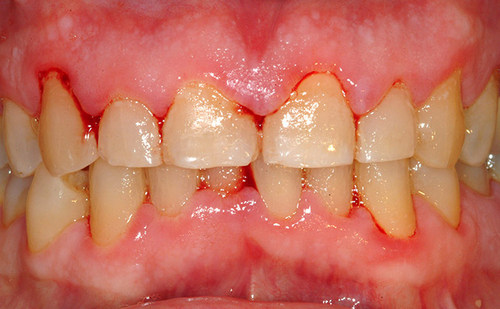
I have recently started a site, the info you provide on this site has helped me tremendously. Thank you for all of your time & work.
Enjoyed reading through this, very good stuff, thankyou .